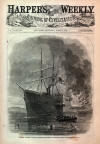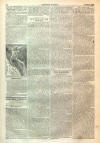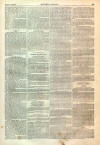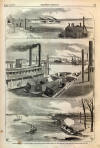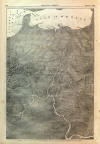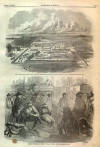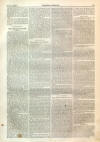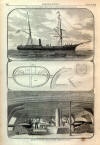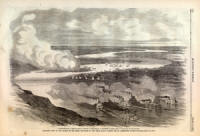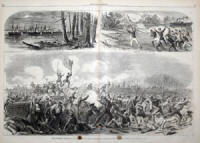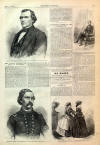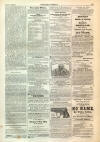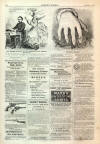The Battle of Newbern
|
|
This Site:
|
APRIL 5, 1862.] HARPER'S WEEKLY. 219 preparations to leave, and gave out that she intended to visit a relative who resided at some distance, in a neighboring Slave State, and there await the return of her uncle. To Bob she gave a sum of money, telling him to get such articles as were necessary, and accompany Mr. Holmes to Cincinnati, where she would meet them. They met, and after the marriage ceremony she presented Bob with his freedom papers as a reward for his conduct. The young teacher and his bride soon left Cincinnati. After a visit to his native village he committed his wife to the care of his mother, and with their blessings he enrolled himself in the army of the Union—was chosen by his comrades as their Captain, and he is now doing battle for God and his Country. THE IRON-CLAD STEAMER "GALENA."ON page 220 we present an accurate view, with diagrams, of the iron-clad war steamer Galena, which is now receiving her final armor at the "Continental Works," Green Point, Long Island—the establishment where the Monitor was constructed. This vessel has generally been spoken of as the "gun-boat Mystic," her hull having been built at Mystic, Connecticut. The word gun-boat very inadequately describes her character, for she is a war steamer of about 1000 tons, carrying a heavy armament, and constructed to combine speed with a power of resistance greater than any other vessel of her class. In ordinary vessels there are spaces left between the timbers which constitute the frame. In the Galena the frame is solid, being composed of timbers of oak and walnut at least 18 inches square; over this is laid the external planking, and inside another planking, bringing her solid thickness up to nearly two feet. Outside of all is the iron armor. This is composed of plates 12 feet long, five inches broad, of rolled iron, varying in thickness from 1 1/4 to 2 inches. These plates are rolled into such a shape as to present a flange upon the upper edge, through which the bolts are driven. This flange is covered by a corresponding one on the lower edge of the plate next above, which covers the bolt-heads, and so on from bottom to top. No bolt-heads are therefore exposed, the whole side of the vessel presenting a smooth iron surface. There are thus two layers of plates, making the entire thickness of her armor from 2 1/2 to 4 inches. The plates present also depressions and elevations, fitting into each other. Figure 4 is an end view of these plates, showing the manner in which they fit into each other. It has been found by experiment that two plates of iron present a greater resistance to a ball than a single plate of the thickness of both. The bolts, instead of being merely driven into the timbers of the sides, pass entirely through, and are secured by nuts on the inside, so that should a bolt become loosened in any way, it may be at once tightened with a wrench. The peculiarity of the model is that the hull presents every where a rounded surface. Looking directly at the stern, the shape is very like the larger end of an egg. In fact an egg will give the best idea of the general form of the hull, only we must suppose it to be elongated to five times its breadth—the length of the Galena being 180 feet, and her extreme breadth of beans 36. From the upper surface we must also suppose about one quarter to be cut off. This flat surface constitutes the upper deck of the vessel; it measures 26 feet at the broadest part, being 10 feet less than the breadth of the vessel at the water-line below. The sides curve from the water-line to the deck. This will be understood by Figure 1, which represents a section of the vessel cut down amid-ships. The advantages of this rounded form are apparent. A ball striking a flat surface at a right angle—that is, in a direct line—exerts its whole force, and either passes through, or is stopped, or rebounds. Now if it strikes at considerably less than a right angle, it glances off in another direction. It will not, however, go as far in this new direction as it would have done in the former one; the difference between these two distances measures the amount of force actually expended upon the object hit. Now a curve may, for practical purposes, be considered as composed of an infinite number of plane surfaces, at angles constantly varying; only one of these surfaces being perpendicular to any particular straight line. Consequently, a ball striking a curve, unless it happens to hit this one point, strikes at an angle smaller than a right angle, and glances off, unless, indeed, its diminished force is sufficient to penetrate the object. The chances are millions to one that a ball will not hit a curve at the precise point in the surface which is perpendicular to its direction. Practically, therefore, the Galena can only be hit by a ball at a small angle. The deck, of which we have spoken, is covered with bomb-proof iron plates. It is not, however, the fighting-deck, upon which the guns are placed. That is below, completely sheltered by this upper deck, which presents nothing, from stem to stern, except a ball-proof pilot-house, and the masts and rigging. At the bottom of the page is a view of the fighting-deck, with its armament of heavy Columbiads, the calibre of which we are not at liberty to state. The Galena is pierced for 18 guns, as will be seen by counting the port-holes. She is presumed to fight head on, "yawing" from side to side, so as to deliver fire alternately from her bow guns. The bows and stern, being the most exposed parts, are protected, in addition to the other armor, by plates of iron. The port-holes are protected by massive iron port-covers, opening in the middle, the upper half being lifted up, and the lower half dropped down, when the guns are to be run out. These port-covers are shown in Figure 3. The vessel is brigantine-rigged, the standing rigging being of wire ropes. Figure 2 is an enlarged view of a portion of the sides, showing the strength of the construction. It is believed that the iron beak of the Virginia, which crushed through the side of the Cumberland as though it were an egg-shell, would strike as harmlessly upon the Galena as it did upon the Monitor. Figure 5 presents the water-line of the vessel when afloat, showing how little of her side is above water, and consequently how small a mark she presents. Figure 6 shows the position of the Engine-Room, which, it will be seen, is below the water-line. Figure 7 shows the position of the officers' apartments. The Galena is one of the three vessels whose construction was recommended last September by the Board of Naval Constructors—the Monitor being another. She was built at Mystic, Connecticut, by Maxson and Fish, Mr. S. H. Pook being the designer. Her iron armor was furnished by the "Rensselaer and Albany Iron Works." The greater part of it was put on at Mystic; but so many delays were occasioned by transporting the iron by railroad in the depth of winter that she was sent to the Continental Works on the 22d of February—a week after launching—to be completed. The bomb-proof deck and pilot-house are constructed by J. T. Rowland, of the "Continental Works." The time of construction, from the day when the keel was laid till that when she will receive her armament, is about 175 days. Her contract price was $235,000. The strength, armament, light draft, and presumed speed of this new vessel, it is anticipated, will render her of special service in our Navy. THE BATTLE OF NEWBERN.WE devote pages 216 and 217 to illustrations of the BATTLE OF NEWBERN—in many respects the most brilliant affair of the war. At this battle, an enemy equal in number, and protected by a line of earth-works a mile long and several casemated forts, armed with rifled guns of heavy calibre, provided with the best weapons, and thoroughly prepared for battle, were completely routed by General Burnside in a few hours. One of our pictures, from a sketch by our artist, Mr. Angelo Wiser, shows THE EMBARKATION OF THE TROOPS for the Expedition at Roanoke Island. They were in high spirits and eager for the fight. Another introduces us to the DISEMBARKATION in the Neuse River. This operation is thus described by the Herald correspondent: The point at which the troops landed is the mouth of Slocum's Creek, about twelve miles below Newbern, by water, and seventeen by land. The Patuxent, Captain Bennett, the flag-ship of General Reno, was the first to enter the creek, General Reno's brigade having the honor of the advance. The Twenty-first Massachusetts regiment, under Lieutenant-Colonel Clark, was on board the Patuxent, and was to have landed first, according to the programme, but the steamer Alice Price, with General Burnside and the Fifty-first New York regiment, glided suddenly by the Patuxent, and ran up as near as possible to the beach, when the color-bearer of the regiment fearlessly jumped overboard into some four feet of water, and holding the flag up over his head waded ashore. Reaching terra firma the flag was unfurled, and the Stars and Stripes once more floated over that portion of North Carolina. Colonel Ferrero followed into the water—an example which his whole regiment soon imitated—and in a few minutes his whole command was ashore. Almost at the same time, and within a briefer period than it takes to narrate it, the other regiments followed, and the water was soon a swarm of men wading ashore, and of launches filled with troops from the vessels further out in the stream. I must not omit to mention that the Pilot Boy, the flag-ship of General Foster, also ran in shore, and the troops on board (Twenty-fifth Massachusetts) likewise jumped into the water. With such alacrity was the landing effected, that in less than an hour the greater portion of the division was ashore. The battle itself, which is illustrated on the same pages (the moment chosen for illustration is the final charge of our troops with the bayonet after they had expended their ammunition), is thus described by the same correspondent: It was now about half past seven o'clock (on the morning of the 14th), and a sharp firing ahead denoted that our skirmishers had encountered the enemy. Rapidly forming, the different regiments assumed their positions in their brigades, and the division marched to the attack. General Burnside rode forward, and as the battery or breast-work came in sight across a wide field, a shot was fired from one of its guns. The missile, which proved to be a shell, struck within ten feet of the General and his staff, but, not exploding, bounced along the ground, splashing the party with mud. General Foster, whose brigade had advanced by the stage road, rapidly formed his regiments in line of battle in the fringe of woods skirting the edge of the field before the breast-work; the Twenty-fourth Massachusetts, Colonel Stevenson, on the extreme right; the Twenty-fifth Massachusetts, Colonel Upton, next, with its left resting on the road; the Twenty-ninth Massachusetts, Colonel Lee, next, with right resting on the road, and the Twenty-third Massachusetts, Colonel Kurtz, on the brigade left, with the Tenth Connecticut in reserve. To support this line against the eighteen or twenty guns of the enemy's battery our forces had only a few pieces of artillery. The rest was on the way, but did not reach the field in time to participate in the fight. The disposition of our artillery in support of General Foster's position was as follows: On the extreme right Executive Officer M'Cook's battery of boat howitzers from the navy, manned by Lieutenants M'Cook, Hammond, Daniels, and Tillotson, with marines and a detachment of the Union Coast Guard. In the centre, and near the road, a 12-pounder steel gun from the Cossack, manned by Captain Bennett, his second mate, Mr. Stroud (captain of the gun), and twenty of the ship's crew. On the left Captain Dayton's battery, from the transport Highlander. After the first gun the enemy run their flag defiantly up over the ramparts and opened very briskly with round shot, grape, canister, and shell. Their infantry were stretched out the entire length of the work between the river and the railroad, and kept up an incessant fire with musketry. Their fire was replied to with equal vigor by the brigade. When it had taken up its position, and leaving them engaged, let me return to the operations of the Second and Third brigades, under Generals Reno and Parke. The Second Brigade, consisting of the Twenty-first Massachusetts, Lieutenant-Colonel Clark; Fifty-first New York, Colonel Ferrero; Fifty-first Pennsylvania, Colonel Hartsruft, and Ninth New Jersey, took the railroad and proceeded along the enemy's right flank. It is somewhat remarkable that the manoeuvres of the battle were nearly the same as those of the fight at Roanoke Island. The point at which the intrenchment crossed the railroad was strongly defended by a series of redoubts and rifle-pits, while a subsequent examination revealed the fact that beyond these redoubts the breast-work was continued nearly a mile and a half, making the entire length of the defenses about three miles. The operations of our forces, however, were confined to that only between the river and the railroad track. The Third Brigade, under General Parke, took up a position on the front, between the First and Second brigades. Such was the disposition of our troops. The engagement regularly opened about eight o'clock, when the First Brigade bore the brunt of the battle. General Foster rode fearlessly along giving his orders, and was several times exposed to the hottest of the fire. His aids, too, shared the danger, and one of them, Lieutenant Pendleton, narrowly escaped injury, if not death, from a bullet which passed through his coat sleeve, just grazing the arm. The Massachusetts Twenty-fourth, on the right, had soon to regret the wounding of two of their officers, Major Stevenson and Adjutant Horton, the former by a ball in the leg, the latter by a ball in the shoulder. Early in the engagement the Massachusetts Twenty-third lost Lieutenant-Colonel Merritt, who was struck by a cannon-ball, which carried at, ay one side of his body, and lacerated his form in a horrible manner. The proportion of officers killed and wounded during the entire fight was quite large. The Twenty-seventh Massachusetts seemed for some reason to be more exposed to the fire of the enemy, and with ammunition expended, and a large loss, were withdrawn. The Tenth Connecticut, until now in reserve, was ordered to their support, and as they fell back took their place; moving to the front with great alacrity, and opening fire with vigor. The Tenth was finally compelled to retire through want of ammunition, and the Eleventh Connecticut took their place. To the First Brigade belong, the credit of having so long and attentively engaged the battery while the Second and Third executed the brilliant manoeuvre of flanking the enemy's right, of which I have now to speak. When it became evident that the First Brigade was capable of carrying on the fight in front, the Third, which had been supporting it, was ordered, with the exception of the Eleventh Connecticut, to support the Second in the flank movement. Accordingly the Eighth Connecticut, Fourth Rhode Island, and Fifth Rhode Island regiments withdrew a short distance into the woods, and defiling to the left came out upon the railroad, and going forward came in the rear of the Third Brigade. This portion of the field of operations was immediately under the command of General Reno, and to him was allotted the task of the flank movement already referred to, and which he so brilliantly and successfully accomplished. It may be well here to state that when the idea of flanking was entertained it was not known that the line of intrenchment extended beyond, or, if it did, much beyond the railroad. When the troops attempted the movement, consequently, of getting in the rear, they discovered not the mere obstacle of swamp or marsh, but also of a series of redoubts and rifle-pits, which defended the immediate vicinity of the track. Our attack in front had so far been confined to the right, near the river, where one of the water batteries had reversed its guns, and was assisting in the defense of the breast-work by an enfilading, or, more properly, diagonal fire upon our troops. The great body of the enemy was consequently here posted, and the flank movement came near resulting in a perfect surprise, thought they rapidly reinforced the redoubts as soon as they discovered the approach on that side. Having drawn out in line of battle, the Second Brigade returned the fire of the enemy vigorously, who, from the rifle-pits and behind the screening edges of the redoubts, were picking off our men with deadly certainty at every shot. But we have to boast of our sharp-shooters also, as many a rebel in these same rifle-pits and behind the entrenchments, whose death-wound was in the head, amply testified. At last the word was given to charge, and the Massachusetts Twenty-first, which was on the left, succeeded in getting four companies within the enemy's position. The New York Fifty-first, which was on the right of the Massachusetts Twenty-first, supported the movement; while the Ninth New Jersey, Fifty-first Pennsylvania, Eighth Connecticut, and Fourth and Fifth Rhode Island assailed the work at various points. The four companies of the Massachusetts Twenty-first were far in advance of the others into the intrenchment, and, driving the rebels before them, had attempted to reverse the guns, when repulsed by a strong reinforcement of the enemy, who suddenly charged from a little ravine or hollow just the rear, and with their overwhelming numbers drove them out, making a few prisoners. Our repulse was but momentary. Re-forming the Massachusetts Twenty-first, New York Fifty-first, Fourth Rhode Island, and the Ninth New Jersey, with the Fifth Rhode Island in reserve, returned to the assault, and after another gallant charge, another desperate resistance of the enemy, a hand-to-hand contest over the ramparts of the intrenchment, in which our forces at one time actually reversed its purpose, and used it as a breast-work for their own protection; while they kept the rebels at bay inside, they drove the enemy out, and at the point of the bayonet chased them back out of sight. The victory was won with the loss of nearly seventy killed and two hundred and fifty wounded—a heavy one when it is taken into consideration that of the two brigades only six regiments and one battalion were engaged. The fire of the enemy was terrific, and embraced all the varieties of missile. General Reno and General Parke admirably conducted the whole manoeuvring, and with their aids and staff were exposed to no inconsiderable danger. When the word to charge was given on the left the cheers with which it was received were heard over on the right, and instantly the First Brigade emerged from its position along the edge of the woods, and, dashing across the fields, assailed the enemy at the very muzzles of their guns. But the retreat of their forces on the flank had inspired all with a panic, and they most ingloriously fled, leaving their cannon unspiked, a number of horses, the caissons, and the unexpended ammunition. They contrived, however, to bear off the greater portion of their killed and wounded; so that it is impossible to form an approximate estimate of their loss, though it can not fall far short of our own. THE FIGHT AT ISLAND No. 10.WE devote page 212 to an illustration of ISLAND NUMBER TEN, showing the rebel positions and likewise that of Commodore Foote's gun-boat and mortar flotilla, and that of General Pope's Union army at New Madrid and Point Pleasant. The correspondent of the Tribune thus describes the position: The river here is in the form of a letter U—running south three miles, next turning to the west half a mile, then again changing abruptly and running for three-miles northward. We descend the right or eastern stroke of the U. At the lower end of the bend, on the west side, just where the stream turns to run northward, is the head of Island No. 10. We are unable to come in full view of it without dropping down completely into the bend, in easy range of its guns, and within half a mile of them; our passage thither would doubtless be disputed by batteries on the Tennessee shore, where the bluff is twenty or thirty feet high. But by looking across to the southwest, over a narrow point of land, and through the branches of the scattering trees which cover it, we can see a part of the Island and the rebel steamboats beyond, on the Tennessee side. Now we read their names with our glasses. We can distinguish the side-wheel transports Falls City, Ohio Belle, John Simonds, Mars, Red Rover, still bearing her old inscription "U. S. Mail Packet," another with no name upon her wheel-house, and the gun-boat Grampus. All have steam on, and their smoke curls up through the trees as they are plying to and fro between the Island and the Tennessee shore. Whether they are carrying soldiers from the Island to the main land, or vice versa, we are unable to determine. We can make out their floating battery, anchored beside the Island. It is said to be constructed of a great flat floating dock from New Orleans; it has no propelling power, but was towed up the river. Two refugees who arrived a few days ago, state that it displayed the sign "Bound to take Cairo." An iron drum or roof, which covers a part of it, is surmised to be for the protection of the men and the magazine; its construction is supposed to be such that there is no compartment under the water. We can count twelve guns upon it, which do not appear to be casemated. There are a great many tents extending along for half a mile on the Tennessee shore, above the head of the bend, and in full view of us over the water; but we are unable to see whether there are any batteries or not. Two of our mortar-rafts have been brought down and anchored to the Missouri shore, the point hiding them from the Island, and we are lying immediately opposite them, in the middle of the stream. On page 213 we give three pictures of the affair, from sketches by our artist, Mr. Alexander Simplot. One represents the MORTAR FLEET ON THEIR WAY DOWN THE RIVER in tow of steamers; another THE RECONNOISSANCE BY COMMODORE FOOTE, the gun-boats dropping down with the current; the third the COMMENCEMENT OF THE BOMBARDMENT. SUNDAY'S FIGHT.The attack commenced on Sunday, 16th. The correspondent of the Chicago Post wrote: The contest is opened by a shot from the Benton, firing "stern on" at the Kentucky battery. Soon after, another missile was sent by the same boat in the same direction, but elicited no reply. Suddenly a sheet of flame and smoke from the mortar-boat darts a hundred feet in the air; the ground seems to tremble as if shaken by an earthquake; the steamboats shake in every timber; a concussion of the atmosphere is felt, as if a single, sudden puff of a whirlwind had moved it; a deafening, stunning noise is heard, which echoes and reverberates among the woods and miles away on either side, and a ponderous shell is whizzing through the air toward the battery, two and one-half miles distant. With eager eyes, the point at which the terrible messenger is directed is watched from the decks of every transport and gun-boat in the fleet. Suddenly a puff of white smoke is seen high in the air over the water, the surface of the river is sprinkled by fragments of the bursting bomb, and fifteen seconds after there comes back to our ears the report of the shattered projectile. Too short? Another, and another still, both of which burst high in the air, and without effect. The spectators grow anxious. Can it be that, after all our labor and our hopes, one of our main dependencies is to fail us? Hark! A fourth of those thunder-rivaling concussions, and shortly after a puff of white smoke is lazily lifted from the dense woods half a mile in the rear of the rebel batteries. Huzza! Their range has not, then, been miscalculated. We can reach them—ay, we can more than overcome the distance. Again a puff of smoke issues from a port in the Benton, and a splash is seen directly in front of what is presumed to be the rebel works. But as yet there is no answering fire. In the course of the afternoon the rebels fired a few shots, but no damage was done. THE BOMBARDMENT ON MONDAY.The same correspondent continues his narrative: The gun-boats weighed anchor at 8 o'clock, and moved slowly up and down the stream; now remaining nearly stationary; then turning, twisting, and crossing from side to side, as if to fully test their ability to hold themselves in the position necessary for operations. The transports, with the exception of the Pike, Wisconsin, and Alps, were ordered further up the stream. These three latter, being powerful tug-boats, were directed to put out into the stream, keeping at distance safe from all danger from the shots of the enemy, but ready at given signal, in case a gun-boat should be disabled by a successful shot from the foe, to drop down alongside, and draw her to a position beyond reach of the enemy's fire. The order was promptly obeyed. At 10.25 o'clock a shell from a mortar was thrown in the direction of a Kentucky battery. It burst high in the air over the enemy's work, and the fragments fell the water far this side of its intended destination. Again that terrible concussion was heard, and this time followed with better effect. The messenger exploded in the edge of the wood, but a short distance in the rear of the gun which responded to our fleet yesterday afternoon, and the returning report was heard accompanied by that dull, heavy reverberation which distinguishes the explosion of a shell in the timber, even when the smoke arising from it can not be discovered. Thus the fight was initiated for the day, and the "top of the morning" conveyed to the foe. Occasional shots from the mortar-boats followed, many of them indifferently aimed, and but few bursting a position calculated to disconcert the rebels, further than probably to make them uneasy as to what might probably happen. At 11 o'clock the whole pack of mortars, with the exception of two, were in full cry, and belching forth with a fury indescribable, and really not conceivable by those who have never heard their deafening voices. The Mound City, stationed about half a mile above Donelson's Point, fired the first shot front the gun-boats at 11.15 A.M., following it up directly after with another of the same sort. Both shots were distinctly seen to raise a vast cloud of sand directly within the rebel works, giving indubitable evidence that they had been well and surely directed. At the sight of this evidence of the immense range of our guns, and the accuracy of those having them in charge, there arose from the decks of the transports bearing troops cheers loud and long, accompanied by waving of hats and divers other eccentric manifestations by which the American race testify their joy. Meanwhile the gun-boats Benton, Cincinnati, and St. Louis, were locked together side by side; the flag-ship in the centre, the St. Louis upon the right, and the Cincinnati upon the left. They dropped slowly down the river to a point close in upon the Kentucky shore, and distant about two and one-half miles from the enemy. With impatience their every movement was closely watched, and lookers-on almost held their breath in suspense and excitement, wrought up by a knowledge that the day was half over, and the action not yet begun. At precisely 1 o'clock the Benton opened fire. The shot struck the water far short of the mark. It was followed by one from the St. Louis, which, bursting but a little above the fort, threw a perfect torrent of iron hail into the opposing battery. A third from the Cincinnati took effect in nearly the same locality, and the battle was formally inaugurated. The fight now raged faster and more furiously upon our side. Shell after shell was distinctly seen to explode in such a manner as to cast upward to the height of the tree-tops a huge cloud of dust. Still they answered not. Others striking in the water seemed to throw the spray far over the little fortress, and bursting projected its iron missiles furiously forward. The cannonading from the fleet grew rapid. The roaring of thunder would render a vivid idea of the terrible concussions which shook every thing for miles around, and which in its rapid successions was terrifically grand. Few shots fell short. One after another these heavy guns poured forth their murderous fire, and the destination of each ball and its effect was as plainly visible as if we were stationed near the fort. Later in the day the rebels replied. The correspondent of the Post says: The enemy's fire was straggling, and given at long intervals. Many of their shots passed high in the air, over the gun-boats, striking the water a great distance beyond. Others, better directed, fell but at few rods in the rear of the "hard heads," and were well aimed. About 3 1/2 o'clock a shot from the enemy came through the spar-deck of the Benton, tearing away the heavy beams of the noble ship, and passing down to the gun-deck rebounded to the upper deck once more, alighting upon a table in front of Commodore Foote's state-room. It did not stop until it had passed through this also, and safely inclosed itself in the second drawer underneath, where it now lies. It is a 64-pounder from a rifled 8-inch gun. LATEST REPORTS.Up to the present time we have no advices of any change. Commodore Foote continues to bombard the rebel batteries, and General Pope cuts off their retreat. It is surmised that our fleet is waiting for the advance of one of our armies from Nashville or Savannah to capture the entire rebel party. At latest dates it was stated that the upper battery of the rebels had been fairly blown to pieces. Only one gun was visible, and that was probably a Quaker. The river is rising steadily, and some of the lower batteries have been overflowed. It is feared that the rebels may be escaping. |
||||||||||||||||||||||
|
|
||
|
|
Site Copyright 2003-2018 Son of the South. For Questions or comments about this collection, contact paul@sonofthesouth.net |
|
|
Are you Scared and Confused? Read My Snake Story, a story of hope and encouragement, to help you face your fears. |
||
